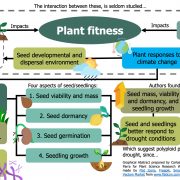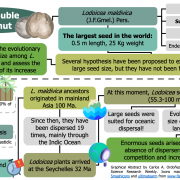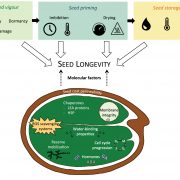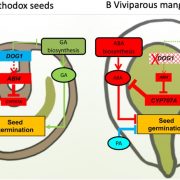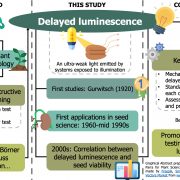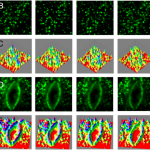Seed tolerance to post-fire temperature fluctuation of Cerrado legume shrubs with micromorphological implications ($) (Flora)
 Legume seeds are typically physically dormant, meaning they have an impermeable seed coat that prevents water uptake. In fire-prone ecosystems, this dormancy is presumably broken when the seed coat is cracked due to being exposed to fire or the daily temperature fluctuations found in burnt sites. However, the role of alternate temperatures in this process has been seldom addressed in tropical systems. Here, Daibes and colleagues test whether simulated post-fire temperature fluctuations affect the germination, viability, and seed coat micromorphology of nine Fabaceae species from the Brazilian Cerrado. Before germination trials, seeds were incubated under room temperature or post-fire temperature regimes (ranging from 18 to 55ºC). The seeds’ hilar region was blocked to test its relative importance for imbibition. Multiple germination responses were found, with fluctuating temperatures either reducing germination and viability or having no effect at all. For instance, scanning electron micrography showed that most species’ seed coat remained practically intact after exposure to post-fire temperature regimes. In contrast to evidence from other regions, this research casts doubt on the role of alternate temperature on breaking physical dormancy in this Neotropical ecosystem. (Summary by Carlos A. Ordóñez-Parra @caordonezparra) Flora 10.1016/j.flora.2020.151761
Legume seeds are typically physically dormant, meaning they have an impermeable seed coat that prevents water uptake. In fire-prone ecosystems, this dormancy is presumably broken when the seed coat is cracked due to being exposed to fire or the daily temperature fluctuations found in burnt sites. However, the role of alternate temperatures in this process has been seldom addressed in tropical systems. Here, Daibes and colleagues test whether simulated post-fire temperature fluctuations affect the germination, viability, and seed coat micromorphology of nine Fabaceae species from the Brazilian Cerrado. Before germination trials, seeds were incubated under room temperature or post-fire temperature regimes (ranging from 18 to 55ºC). The seeds’ hilar region was blocked to test its relative importance for imbibition. Multiple germination responses were found, with fluctuating temperatures either reducing germination and viability or having no effect at all. For instance, scanning electron micrography showed that most species’ seed coat remained practically intact after exposure to post-fire temperature regimes. In contrast to evidence from other regions, this research casts doubt on the role of alternate temperature on breaking physical dormancy in this Neotropical ecosystem. (Summary by Carlos A. Ordóñez-Parra @caordonezparra) Flora 10.1016/j.flora.2020.151761


